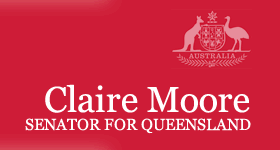Senator MOORE (Queensland) (18:58): In recent years there has been considerable research aimed at identifying Indigenous Australians who fought in our armed services during the period up until the 1970s. This research has been done mainly by individuals working privately, with some research projects funded by public institutions. The main institutions involved in this valuable work are the Australian War Memorial and the Australian Institute of Aboriginal and Torres Strait Islander Studies. Also at the Australian National University there has been some focused research on Indigenous people serving in the armed forces. Individuals who have done significant work include Philippa Scarlett and Dr Dale Kerwin of Griffith University. There are a number of individuals, mainly military historians, who contribute to the research. They are mainly interested in various areas of military history but are aware of the need to recognise Indigenous Australians. About 20 historians have made contributions in this area. They work really hard on an issue that needs more consideration, particularly as our community is looking more closely at our military history as we lead through this series of celebrations and acknowledgements over the next few years.
It is difficult to know exactly how many Aborigines and Islanders served in World War 1 because, up until after the Second World War, Indigenous Australians were formally barred from joining the defence forces. But we know they served, and we know they served in both wars. Often they received no recognition and after their service returned to live in their own communities, sometimes without any kind of memorial or acknowledgement of the service they had provided to their country.
The latest number who served in World War I that can be given with certainty is that some 1,800 Indigenous Australians served in our forces at that time. It is a number that is changing as the research continues. Some 324,000 Australians served in World War I, making this a very large research project. It is difficult to identify specifically Indigenous Australians who served because of a number of factors: (1) they were not formally allowed to serve; and (2) race was rarely indicated or recorded and usually only when rejecting a man's application. Some gave stories about their background such as being Maori or West Indian to explain their dark complexion. Ironically both those groups were not exempt from enlistment. There was also an expectation that there was some genuine prejudice in the community at the time, so people were reluctant to identify.
The researchers are guided mainly by family history and information from various state government bodies that managed Aboriginal people before 1967. Those records are now a valuable source of recognition. For the researchers it is a slow business of piecing together fragments from diaries, official records and memoirs. Often things are misremembered or impressions from many years ago are wrong. At times there is a photograph that can stimulate memory, and hours can be spent searching to get that proof. We know that families are very keen to have the stories of the ancestors known and celebrated, and tonight I want to talk about a couple of the men whose stories have now been recorded.
William Allan Irwin, a man of the Gamilaraay people from north-west New South Wales and south-west Queensland, was born at Coonabarabran in New South Wales. He was a 37-year-old shearer when he enlisted in 1916 at Narrabri. On his enlistment papers he is described as being five foot nine inches tall, weighing 145 pounds, with a chest measurements of 32 ½ to 35 inches. That is all very valuable information, but there is nothing about him being a strong Gamilaraay man. He had a dark complexion, dark brown eyes and black hair. There is only one known photo of him in a group of 19 men from his unit, his mates. The only way that they can point out William in the photo is that he had a small moustache.
He was allocated to the 33rd Battalion based at Armidale, drawn from the New England area of New South Wales. He did basic training in Sydney. He was in action and was wounded twice, once in 1917 and again in 1918, as well as becoming ill with scabies in January 1918. He was in the major offensive of March 1918 in the Somme and was part of a very strong action where he was awarded the Distinguished Conduct Medal, the second highest award for gallantry, and it is extraordinarily important that we acknowledge that. He died in Daours and is buried at the Daours Communal Cemetery Extension. The citation for William's medal says:
Single handed and in the face of extremely heavy fire Private Irwin rushed three separate machine gun posts and captured the three guns and crews. It was while rushing a fourth machine gun that he was severely wounded.
We should recognise that he was a strong man who died for his country that did not acknowledge him a citizen at the time.
The other man I want to mention is Benjamin Combo, who was from Dalby-a place I know well; it is quite close to where I grew up. Little is known of his life outside of his Army records, but it seems that by 1915 his parents had died and he named his uncle and aunt as next of kin. In December 1915 he was at a recruiting depot in Bendigo where he was medically examined and attested. He was 26 years and six months of age and was working as a horse breaker. His papers were endorsed 'half-caste Aboriginal'. He was sent for training, and on 18 December they sought advice as to whether he should be enlisted as he was very dark for a half-caste. As a result he was discharged in 1916 as 'not being of direct European descent'.
Some nine months later he tried again in Albury, New South Wales. He enlisted again and got accepted, but those papers did not say 'half-caste'. He left Sydney on HMAT A24 Benalla bound for the United Kingdom. He died of an pneumonia and was buried at sea. The Australian authorities were advised of this when the ship docked at Plymouth, and a telegram was sent to his next of kin, his aunt, but it was not delivered as she had left that address. His personal effects were never returned. After the war the Army took some considerable trouble to find his next of kin to forward his war medals. Eventually his brother, Bertie, was located at Murgon, and in June 1923 Bertie received Benjamin's British War Medal, a memorial plaque and a message from King George V. The only known memorial to Benjamin Combo is a brass plaque at the Albury War Memorial. It records his name and date of death, but no indication that he was an Aboriginal Australian.
It is important that we acknowledge the service that our Aboriginal people gave at a time when, as we know, in our history they were not recorded as Australian citizens. I want to applaud the work of those tireless researchers who are working to ensure that our records are complete, and that we have acknowledgement for the people who served our country so well and who showed such loyalty. We know that Indigenous Australians served for the same reasons as their white counterparts: patriotism; loyalty to what they considered their country; a sense of adventure; the lure of overseas travel;-which is ironic, when you think about it, that the lure of travel encouraged people to go so far away, and many did not come home-and the extraordinary rate of pay of six shillings a day.
I think it is also the fact that, once people were actually signed on, once they got through the threshold of having their enlistment accepted, there was a strong sense of equality within the Australian Forces. There was none of the segregation of units, which we have seen in the US services. People did have a sense that they were working and serving their country together, so that was also an incentive. Within the service, particularly the Army as we know, all the men knew that they were fighting together and it did not really matter, once you were in that fight, whether you were Aboriginal, or whether you were white, or whether you from were from another ethnic background.
There has also been considerable work done on people of Chinese descent who were in the Australian services, and there is a splendid book about the Chinese ANZACS which is available at the Australian War Memorial. We need to do more work and research. During the celebrations and acknowledgements over the next few years, as we look at major battles where Australians have served, it is important to know that amongst those Australian servicemen there were people of Aboriginal descent who were fighting for our country.




